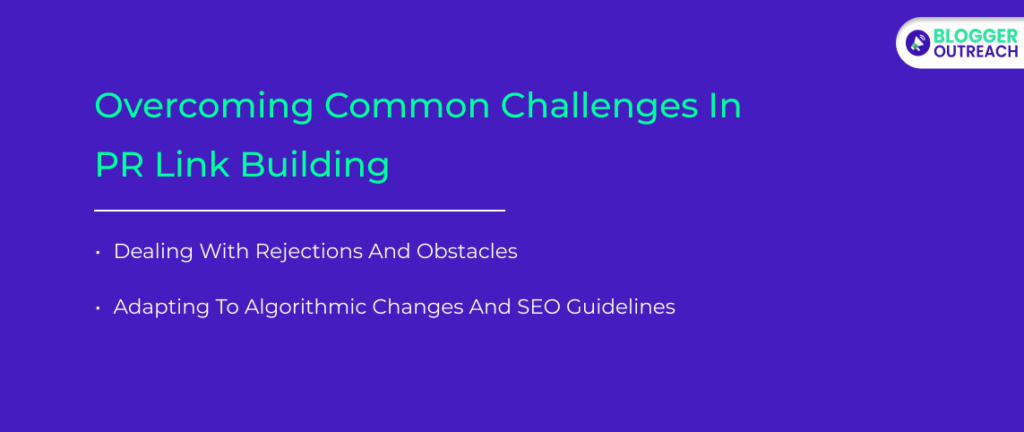Table Of Content
- 1 Definition And Purpose Of PR Link Building
- 2 Factors Influencing Successful PR Link Building
- 3 Developing An Effective PR Link Building Strategy
- 3.1 1. Setting Clear Objectives And Goals
- 3.2 2. Identifying Target Audience And Relevant Publications
- 3.3 3. Conducting Competitor Analysis And Industry Research
- 3.4 4. Creating High-Quality Content For PR Link Building
- 3.5 5. Establishing Relationships With Journalists And Influencers
- 3.6 6. Leveraging Social Media For PR Link Building
- 4 Tips For Outreach And Relationship Building
- 5 Overcoming Common Challenges In PR Link Building
- 6 Measuring The Success Of PR Link-Building Campaigns
- 7 Conclusion
Google search trend analyst John Mueller believes in including Digital PR in your Link Building Strategy. It’s not spam and can be as crucial as Technical SEO.
Check Out What He Said:

As you can see from the above statement, Google thinks PR link-building is good.
Now, you might be wondering about the following aspects:
How does PR link-building work?
When it comes to PR link building, what factors matter?
What’s the best way to develop a PR strategy?
How should I reach out and get things done?
What are the best ways to measure PR link building?
You just need to relax! If you have any doubts or questions regarding PR link building, this article will clarify them for you.
Definition And Purpose Of PR Link Building

PR link building aims to improve a website’s authority and visibility through high-quality backlinks from reputable publications.
Unlike traditional link building, which focuses solely on SEO metrics, PR link building emphasizes creating genuine relationships with journalists and influencers.
Search engines favour websites with PR links because they boost their credibility and authority and generate referral traffic from relevant publications. Businesses can gain a wider audience by securing backlinks from authoritative sources.
Difference Between Traditional Link Building And PR Link Building
Businesses seeking to enhance their online presence must understand the difference between traditional link building and PR link building.
Although both strategies aim to increase website visibility and attract organic traffic, their approaches differ.
Traditional link building focuses on acquiring backlinks from various websites to boost search engine rankings. It often relies on tactics like directory submissions, article submissions, and social bookmarking.
Conversely, PR link building integrates public relations principles into the process by leveraging media coverage and influencer relationships. Natural backlinks are acquired by creating valuable content that resonates with target audiences.
Traditional link building may garner immediate results regarding search rankings.
In contrast, PR link building fosters long-term brand credibility and authority through genuine connections with journalists and influencers.
Businesses can establish themselves as industry leaders by focusing on quality over quantity.
Factors Influencing Successful PR Link Building
With PR link building, several factors are crucial in determining its success.
✅Firstly, understanding and identifying your target audience is paramount. Understand their interests, preferences, and online behaviour. Hence, you can tailor your outreach efforts to resonate with them effectively.
✅Secondly, forging genuine relationships with journalists and influencers greatly influences the outcome of your PR link building endeavours.
Cultivate Meaningful Connections By:
- Engaging in thoughtful conversations.
- Providing valuable insights.
- Demonstrating a genuine interest in their work.
✅Lastly, staying up-to-date with industry trends and news is essential for successful PR link building. Keep an eye on emerging topics and current events relevant to your business niche. In turn, you can position yourself as a knowledgeable expert who can offer unique perspectives and insights.
Developing An Effective PR Link Building Strategy
We have broken down PR link building into six actionable strategies. Make sure you read each one carefully and put them into practice as soon as possible.
1. Setting Clear Objectives And Goals

Without a clear direction, businesses risk wasting time and resources. So, set up measurable goals.
By tracking their progress, you can ensure your marketing efforts align with their goals.
When setting objectives for PR link building, it’s important to consider both long-term and short-term goals.
The Long-Term Goals May Include:
- Enhancing brand visibility.
- Improving search engine rankings.
- Increasing website traffic.
Short-Term Goals Can Focus On:
- Securing a certain number of high-quality backlinks from reputable publications.
- Generating buzz around a new product launch.
Businesses need clear objectives not only to succeed but also to keep their people motivated. Everyone feels more motivated and engaged if they know why they’re doing what they’re doing. Businesses can work toward enhancing their online presence and reputation with well-defined PR link building goals.
2. Identifying Target Audience And Relevant Publications

This is a golden rule for any marketing strategy. PR link building is no exception.
This requires a deep understanding of the demographic and psychographic characteristics of the desired audience.
Delving into their preferences, interests, and online habits. This will help you tailor your outreach efforts to specific publications that are more likely to capture the target audience’s attention.
Moreover, identifying relevant publications goes beyond just considering their readership numbers. It involves meticulously examining the publication’s authority, credibility, and alignment with the business’s industry or niche.
The publication selected should have an established reputation, values aligned with the business’s, and a large audience. You can increase your brand’s visibility by picking reputable publications and their target audiences.
Choosing target audiences and publications for PR link building activities is not just about quantity but also quality.
Your business will benefit from aligning its brand message with credible platforms that share your values.
3. Conducting Competitor Analysis And Industry Research

Competitor analysis and industry research are key to PR link building. This process allows businesses to identify their rivals’:
- Successful link building strategies.
- Uncover valuable opportunities.
- Fine-tune their own approach.
When analyzing competitors, it is important to assess the quality and quantity of their backlinks. Look for authoritative websites that are linking to them, as these can be your potential targets.
Additionally, examine the content types they produce and promote, such as articles, infographics, or videos. This will help you understand what resonates with your target audience and provide inspiration for your own content creation.
✅Industry Research
Stay updated with your industry’s latest trends, news, and developments. You can tailor your outreach efforts by being aware of newsworthy topics or emerging influencers related to your niche.
Moreover, When you understand your target audience’s interests and preferences, you can craft compelling pitches for journalists and influencers.
Staying ahead of the competition requires diligence and creativity in competitor analysis and industry research.
By gaining insight into current market trends, a robust strategy can be developed that maximizes chances of success.
4. Creating High-Quality Content For PR Link Building

Businesses must prioritize creating high-quality content to establish a strong online presence and attract valuable backlinks.
But what exactly does high-quality content entail?
It goes beyond mere words on a page; it encapsulates value, relevance, and creativity.
Firstly, high-quality content should provide value to the target audience. It should address their pain points, answer their questions, and offer practical solutions. Delivering valuable insights and expertise can help businesses establish themselves as trustworthy authorities.
Moreover, relevance is paramount in creating compelling content. A message tailored to the target audience’s interests and needs helps forge a deeper connection. It’s easier to create content that’s relevant to customers if you understand their needs.
Lastly, injecting creativity into content elevates its impact. Unique angles and perspectives captivate readers and attract journalists and influencers. Innovative storytelling techniques or visually appealing elements can make your content stand out.
By combining these elements – value, relevance, and creativity – quality backlinks can help businesses create exceptional content that resonates with their audience.
Remember: when it comes to PR link building through content creation, strive for excellence rather than settling for average results.
5. Establishing Relationships With Journalists And Influencers

Businesses can increase their chances of securing valuable coverage and gaining high-quality backlinks by forging connections in the media industry.
Building relationships with journalists involves taking a personalized approach tailored to their interests and needs.
In addition to journalists, collaborating with influencers can amplify the reach of PR efforts. Influencers have a strong online presence and a loyal following, making them valuable partners for promoting businesses’ content or products.
✅Crafting Compelling Press Releases And Media Pitches
To craft a compelling press release, you must ensure that:
- It delivers a captivating headline.
- Provides concise and relevant information.
- Incorporates engaging storytelling elements.
You Can Effectively Convey Your Message To The Target Audience By:
- Highlighting unique selling points.
- Leveraging data-backed insights.
- Emphasizing the value proposition,
A well-crafted press release should be newsworthy and timely, arousing curiosity among journalists. Structure it meticulously.
Additionally, making the press release credible with relevant quotes from industry experts creates a human connection.
For media pitches, businesses must tailor their messaging to the specific journalists or influencers they target. A personalized pitch makes a difference in a crowded inbox.
Business owners can establish rapport with journalists by demonstrating an understanding of their work and interests.
PR campaigns with a thoughtful research approach are more likely to capture media attention and secure valuable coverage.
✅Guest Posting On Authoritative Websites And Blogs
By contributing high-quality content to reputable platforms in your industry…
…you gain valuable backlinks, establish yourself as an expert, and build brand visibility.
When selecting sites for guest posting, focus on those with strong domain authority and a relevant audience that aligns with your target market.
Conduct thorough research to identify suitable websites and blogs to execute guest posting.
Look for platforms with an engaged readership and regularly publish content related to your industry or niche. After compiling a list of potential targets, take the time to understand their content guidelines and submission processes.
Crafting compelling and unique content is essential when guest posting. Ensure that the content must resonate with the target audience of the website or blog.
Delivering high-quality content consistently increases the chances of getting accepted as a guest author. In turn, it creates further opportunities for future collaborations.
Remember, guest posting should not solely focus on self-promotion. It should provide value to readers while subtly showcasing your expertise.
✅Participating In Expert Interviews And Podcasts
These platforms provide an excellent opportunity to showcase your expertise and establish yourself as a thought leader. It builds valuable connections with influential individuals within your industry.
When participating in expert interviews, be prepared to share valuable insights and practical advice that can benefit the audience. Offer unique perspectives or innovative solutions to common challenges businesses in your niche face.
Podcasts are another fantastic avenue for expanding your reach and building links. Engage with podcast hosts who cater to your target audience. Share relevant topics that resonate with their listeners.
Subtly promote your brand or website while providing informative discussions or captivating stories. Podcasts show notes and related blog posts that are memorable and impactful and are more likely to secure quality backlinks.
Besides building PR links, expert interviews and podcasts foster valuable relationships within your industry. Connect with like-minded professionals, collaborate on future projects, and collectively elevate each other’s success.
✅Building Relationships Through Networking Events And Conferences
Here, you get the chance to build meaningful connections with journalists, influencers, and industry experts.
These Events Serve As A Platform For:
- Exchanging ideas.
- Fostering collaboration.
- Building relationships.
When attending these events, make a concerted effort to engage in meaningful conversations with fellow attendees.
Approach each interaction with genuine curiosity and show a keen interest in understanding their perspectives. You can leave a lasting impression when actively listening and asking insightful questions.
Additionally, consider organizing your own networking events or participating as a speaker at relevant conferences. This positions you as an expert in your field. Plus, it lets you showcase your business’s value proposition to a wider audience.
Remember, every interaction has the potential to open doors and create opportunities for fruitful partnerships.
Fostering relationships takes time and effort. Be patient, authentic, and respectful throughout the process.
6. Leveraging Social Media For PR Link Building

One effective way to utilize social media is by creating engaging and shareable content that attracts attention from journalists, bloggers, and industry influencers.
Craft compelling posts, articles, or infographics that resonate with your target audience. Encourage them to share your content across their networks. It increases your chances of gaining valuable backlinks.
Moreover, social media offers a unique opportunity to engage with journalists and influencers directly. Leverage Twitter chats or LinkedIn groups to do so.
So why not embrace the power of social media in your PR link building strategies?
Lastly, stay active on platforms where your target audience resides. Create compelling content that resonates with them.
Tips For Outreach And Relationship Building
Building relationships takes time and effort, but the rewards are worth it. Here, you need a strong network of journalists and influencers. Stay patient, persistent, and professional.
✅Personalizing Outreach Emails And Messages
Say goodbye to those old, generic emails that often get lost in journalists’ inboxes. Instead, invest in research and understanding your audience before reaching out.
Personalize your messages to cater to their specific needs and interests, making them feel unique and appreciated.
When tailoring your outreach emails, use the recipient’s name instead of a generic greeting. Show sincere interest in their work by mentioning recent articles or projects they’ve undertaken.
Consider adding a personal touch to make your message even more memorable, like…
…highlighting a particular aspect of their work that resonated with you or providing unique industry insights.
It’s crucial to remember that successful outreach is all about building relationships.
You can secure valuable PR links and cultivate meaningful relationships with journalists and influencers by showing genuine interest in their work.
Approach each email as an opportunity to establish rapport and leave a lasting impact.
✅Following Up And Maintaining Relationships With Journalists
After your initial outreach, it’s essential to follow up promptly. Craft personalized follow-up emails expressing genuine interest in their work. It reflects that your story or content can benefit their audience.
In your follow-up, reaffirm your value and provide additional information or angles to capture their attention.
Express gratitude for their time and offer further assistance. Building rapport with journalists requires ongoing effort. So, schedule regular check-ins to stay on their radar without being intrusive.
Please remember that journalists following up isn’t just about pitching stories. Engage with them on social media by sharing and commenting on their content.
Attend events where they’re present for face-to-face interactions that strengthen connections. Nurturing these relationships over time increases your chances of future collaboration and valuable PR links.
✅Offering Value And Being A Reliable Source Of Information
It’s essential to provide valuable content and become a trustworthy information source. Share insightful articles, whitepapers, or case studies with unique perspectives and practical advice.
Embrace the role of an educator, empowering your audience with valuable insights that positively impact their lives. Consistently deliver high-quality content to build trust and credibility among industry journalists and influencers. Show that you’re promoting your business and genuinely contributing to your readers’ well-being.
Remember, generosity leads to reciprocity. Share your expertise generously without expecting anything in return, and you’ll discover doors opening effortlessly. This approach sets you apart from those solely seeking self-promotion.
Overcoming Common Challenges In PR Link Building

Refrain from making the below-mentioned challenges when it comes to PR link building.
1. Dealing With Rejections And Obstacles
Navigating the world of PR link-building can sometimes be met with rejections and obstacles. It’s important to remember that setbacks are a natural part of the process, and every “no” brings you one step closer to a “yes.”
Embrace rejection as an opportunity to learn, adapt, and improve your approach. Stay persistent in your outreach efforts, refining your pitch and targeting the right publications. With resilience and determination, you will eventually secure valuable links for your business.
2. Adapting To Algorithmic Changes And SEO Guidelines
In a dynamic world of search engine algorithms, staying current with the latest SEO guidelines is vital. What worked previously might not be effective today.
Embrace these changes as opportunities to enhance your PR link building strategies with innovation and resourcefulness. Keep an eye on industry trends, stay informed about algorithm updates, and adapt your tactics to align with current best practices.
Measuring The Success Of PR Link-Building Campaigns
Now that you have set up a PR link building campaign. So, how can you gauge their impact and make informed decisions for future strategies?
By defining key performance indicators (KPIs), you can track and measure the success of your efforts. KPIs may include metrics like quality backlinks, mentions in prominent publications, and search engine optimization.
Employing analytics tools like Google Analytics or Moz’s Open Site Explorer allows you to dig deeper into data, extracting invaluable insights. Monitoring the growth of backlinks over time reveals trends and patterns signifying progress.
Furthermore, assessing the impact on website traffic and search rankings offers a holistic view of how your PR link building efforts enhance your online presence.
Keep in mind, that effective measurement not only offers quantitative data but also qualitative analysis, examining factors such as brand visibility, audience engagement, and industry influence.
These measurements demonstrate how your PR link building work improves your brand reputation and opens doors for further growth.
A. Defining Key Performance Indicators (KPIs)
Selecting the right Key Performance Indicators (KPIs) is vital for gauging PR link building campaign success. KPIs act as benchmarks to assess the impact on web traffic, search rankings, and brand visibility.
In PR link building, key KPIs include organic site visits, referrals from linked publications, landing page conversion rates, social media engagement, and backlink acquisition pace. These metrics offer valuable insights into the PR efforts’ influence on generating leads and positive business outcomes.
By carefully defining and monitoring these KPIs, businesses can comprehensively gauge ROI, including:
- Increased brand exposure.
- A better online reputation.
- Higher revenue.
Monitoring these indicators helps companies continuously fine-tune their strategies and optimize PR link building campaigns for maximum impact.
B. Using Analytics Tools To Track And Analyze PR Links
To assess your PR link building’s impact, use analytics tools for tracking and analysis. They unveil insights on PR campaigns affecting web traffic, search rankings, and brand visibility. By monitoring and measuring PR link success, data-driven decisions optimize your strategies for better results.
Google Analytics, for instance, lets you set custom tracking parameters for each PR link. It pinpoints referral traffic sources and measures conversion rates. Analyzing visitor behaviour, like time spent and pages visited, guides future outreach.
Moz’s Link Explorer, another potent tool, offers data on PR link performance, including domain authority, page authority, and more. Assess the quality of sites linking to yours via PR efforts. Armed with this info, prioritize influential publications for a positive online reputation.
C. Evaluating The Impact On Website Traffic And Search Rankings
Monitoring these metrics offers insights into PR campaign effectiveness and informs data-driven strategy improvements.
Analyzing web traffic helps assess PR link performance. Increased organic traffic indicates successful PR efforts, attracting a broader audience. Identifying sources driving substantial visits allows businesses to nurture those relationships.
Evaluating search rankings clarifies online visibility enhancement. Improved keyword rankings signify media coverage boosting authority in search results. This enhances visibility and engagement opportunities.
Conclusion
PR link building is a potent tool for boosting online presence and organic traffic.
Establish journalist and influencer relationships, create outstanding content, and utilize social media to build your brand.
Despite challenges, resilience and adaptability enable your business’s voice to flourish despite digital noise.
This leads to fruitful connections, elevated credibility, and a thriving business ecosystem.
Read More:








